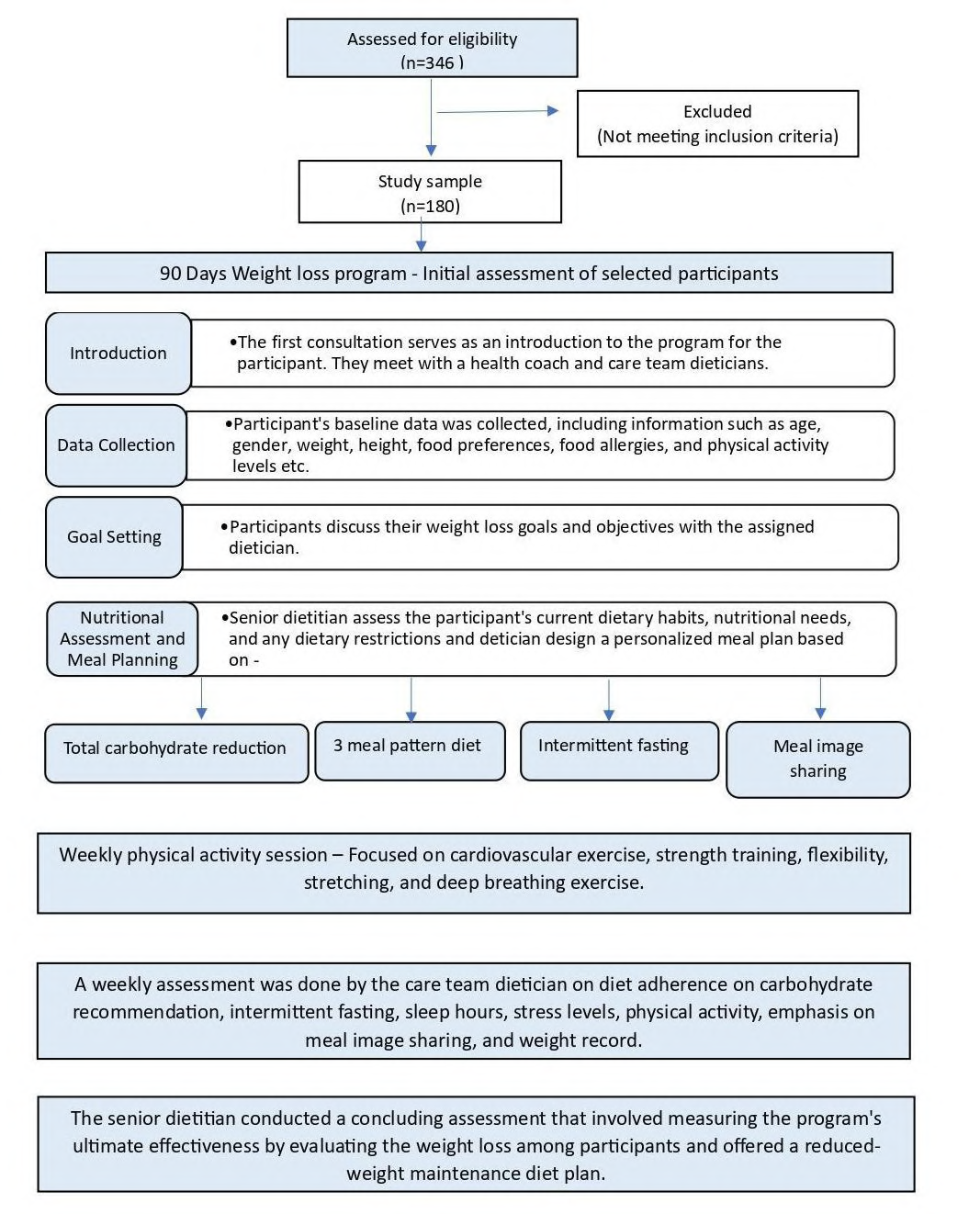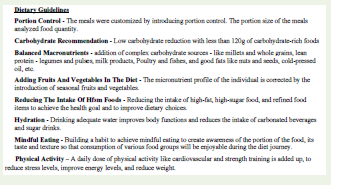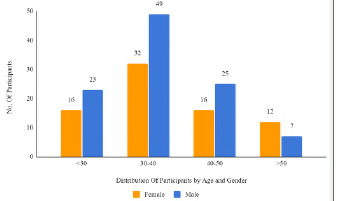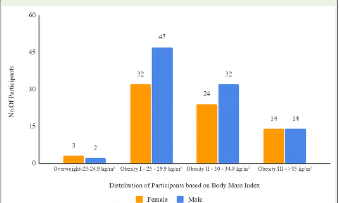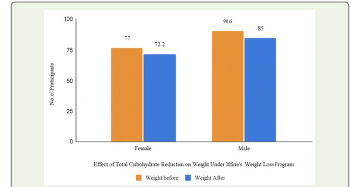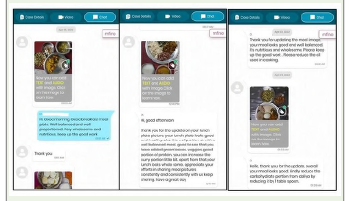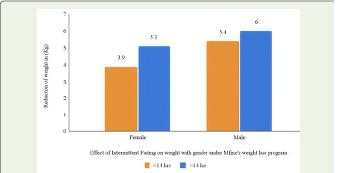Research Article
Evaluating the Impact of Personalized Digital Weight Loss Program: A Study on Overweight Individuals with the Implementation of Intermittent Fasting, Carbohydrate Reduction, and Meal Image Monitoring
Panwar B*, Indana R, Bhagyasri A, Bharadwaj A, Prabhu MU, Duggani M and Kattika S
Department of Nutrition and Dietetics, Mfine Bengaluru. India
*Corresponding author:Bhawi Panwar, Department of Nutrition and Dietetics, Mfine Bengaluru. India Email Id: bhawi.panwar@mfine.co
Article Information:Submission: 17/01/2024; Accepted: 12/02/2024; Published: 16/02/2024
Copyright:©2024 Panwar B, et al. This is an open-access article distributed under the Creative Commons Attribution License, which permits unrestricted use, distribution, and reproduction in any medium, provided the original work is properly cited.
Abstract
Global obesity, marked by excess body fat, poses severe health risks, straining healthcare systems. Effective weight management strategies that are practical and sustainable are crucial to combat this growing health crisis. One such approach involves the utilization of digital interventions to provide structured
and personalized weight loss programs. This study focuses on evaluating the effectiveness of the digital solution, Mfine’s Weight Loss Program (WLP), targeted at overweight individuals as defined by Body Mass Index (BMI) criteria. The primary objective of this research is to evaluate the effectiveness of
Mfine’s digital Weight Loss Program in overweight individuals by determining the average weight reduction achieved through the implementation of intermittent fasting and carbohydrate reduction. Furthermore, the study aims to evaluate the benefits of digitally monitoring recommended diets through meal images. This
study involved 180 participants within a wide age range of 18 to 80 years with overweight conditions. Participants received personalized support from health coaches, dietitians, and fitness trainers along with adjustments to their daily lifestyles. The study assessed effectiveness by comparing participant’s initial and
final weight measurements over 90 days.
Results revealed a significant (p<0.001) reduction in weight for both genders, with promising outcomes in terms of weight reduction. Among the 180 participants (76 females, 104 males), the average initial weight for females was 77 kg and males were 90 kg. At the program’s end, the average weight reduction for females was (72.2±3.91) kg and for males was (85±3.95) kg.
In conclusion, the study has offered a simplified lifestyle intervention with a focus on behavior through mobile health monitoring demonstrating feasibility and positive reception. It indicates positive outcomes in weight reduction. Importantly, the incorporation of meal image monitoring effectively records dietary
habits, allowing timely personalized advice and tailored nutritional approaches that result in improved participant outcomes.
Keywords:Obesity; Mfine app; Meal images; Digital nutrition; Weight loss program; Intermittent fasting; Carbohydrate reduction
Introduction
The prevalence of overweight and obesity is on the rise worldwide,
affecting both developed and developing nations and it is a global
concern [1]. With over 1 billion individuals affected, including 650
million adults, 340 million adolescents, and 39 million children.
Unfortunately, this number continues to rise, and the World Health
Organization predicts that by 2025, around 167 million individuals,
both adults and children, may experience adverse health outcomes
due to excess weight [2]. In India, obesity is one of the major health
concerns, resulting in a significant financial and medical burden
on the country’s healthcare system. The statistical analysis of 2019
showed that the prevalence of obesity has doubled in the last decade
[3]. A higher prevalence of obesity in India is attributed to changes
in dietary habits, urbanization, sedentary lifestyle, socio-economic
status, and lack of healthcare facilities and financial support [4,5].
There has been an increasing trend in the availability of high-calorie
foods at a lower cost across rural and urban areas, as a result of which
the consumption of higher-calorie low nutrient-dense foods has been
observed in many surveys [6]. Urbanization and decreased physical
activity have led to a significant shift in lifestyle, resulting in a decline
in overall quality of life alongside the rapid increase in health issues
in recent years. Public health interventions are needed to prevent
and manage obesity and its associated complications in India such
as diabetes, hypertension, dyslipidemia, cardiovascular issues, and
cancer [6,7].
In the past years, two popular therapeutic strategies that have
gained attention are therapeutic carbohydrate reduction and
intermittent fasting. Both of these dietary interventions have shown
promising results in promoting weight loss and improving health [9].
Further, adhering to the weight loss diet and maintenance is a persisting
challenge [10]. Thus, there is a need for a feasible, sustainable, longterm,
and effective weight loss approach. Since weight management
requires sustainable behavioral change, adhering to lifestyle changes
could be infrequent and difficult without the proper support from a
healthcare provider and peer. Thus, the use of mobile applications and
digital tools for weight management is becoming prevalent as it is easy
to access, helps to eradicate issues, and allows real-time tracking of
dietary habits [11]. Using the plate method as a nutrition educational
tool has demonstrated superior efficacy in fostering positive dietary
changes and enhancing health outcomes for individuals with
interventions centered around carbohydrate counting or calorie
counting [12].Tracking the meal images and analyzing the root cause
of nutritional deficiencies provide valuable insights into individuals
dietary habits and contribute to a comprehensive understanding of
their nutritional needs [13].
Thus we propose a Mfine digital therapeutic program that
provides personalized lifestyle management support for people
with overweight. This program consists of the initial application of
continuous meal image monitoring, a multidisciplinary care team of
experts comprising clinical dietitians, dedicated health coaches, and
fitness coaches to deliver tailor-made nutrition plans, progressive
fitness routines, and behavioral modification strategies for effective
and holistic weight management. A key aspect of the program is
the encouragement of meal image sharing, where participants can
showcase their meals and receive real-time dietary suggestions.
Additionally, participants are guided to follow intermittent fasting
and to reduce carbohydrate-rich foods.
The current study aims to evaluate the effectiveness of Mfine’s
digital “weight loss program” by determining the average weight
reduction in overweight individuals through the implementation
of intermittent fasting and carbohydrate reduction. Additionally,
the objective is to assess the benefit of digitally monitoring the
recommended diet through meal images.
Materials and Methods
Study Design:
This is a retrospective study which is conducted over 90 days
based on the analysis of the deidentified data of participants enrolled
in the Mfine’s WLP. Participants were recruited through direct
referrals by the treating physician on the Mfine application, via a
social media campaign offering a weight loss program, through
corporate tie-ups, and through webinars. The data was collected based
on the characteristics of an individual, such as dietary habits, total
carbohydrate intake, number of fasting hours in a day and physical
activity.Inclusion and exclusion criteria:
The following were the Inclusion Criteria of the study:
1. BMI > 23
2. Age >18 years at the time of enrollment.
3. Having a smartphone and being willing to utilize the
application.
4. Participants enrolled in the Mfine weight loss program from
April 2021 to April 2022.
The following were the exclusion criteria of the study, as the
primary focus was to analyze the impact of the intervention on
overweight individuals:
1. BMI <23
2. Age <18 years at the time of enrollment.
3. Presence of underlying health conditions or comorbidities
that require specialized medical management.Ethical consideration:
Consent was obtained on the Mfine application as per the
telemedicine guidelines released by the government of India in the
year 2020. The privacy policy of the Mfine application also mentioned
“data would be used for research purposes”. All the participants
had voluntarily enrolled for the Mfine weight loss program. Mfine
maintains the protection of privacy and confidentiality of participants
by ensuring that the study data are de-identified. Participants were not
provided any compensation for study participation.Duration of the Study:
From April 2021 to April 2022, 90 days were counted from the
date of enrollment. Data collection was done after the ethical clearance
from the IEC (Institutional Ethics Committee).Data Collection:
In this research study, we utilized a combination of the Structured
Interview technique and a questionnaire method conducted in the
English language, where among the enrolled participants, no one
was suffering from diabetes. Through these methods, we gathered
information on various aspects, such as family history, medical
records, stress levels, sleep duration, screen time, diet recall, and
physical activity. These details were collected during the initial call
with each participant and carefully documented. Additionally, all
subjects were individually contacted and interviewed using the
questionnaire.Anthropometric measurements, such as self-entered data provided
by the participants regarding their weight in kilograms, height in
centimeters, and age in years, were collected. With this information,
the Body Mass Index was calculated (BMI is derived from a person’s
weight in kilograms divided by the square of the person’s height in
onmeters square - kg/m2) [14]. Furthermore, a customized diet plan
was provided to the participants, focusing on reducing overall calorie
intake from carbohydrate-rich foods and implementing intermittent
fasting for 12-16 hours. Participants were encouraged to share meal
images depicting their food intake to aid in assessing and monitoring
their dietary adherence. The number of hours of fasting was
determined based on the mentioned meal timings in the diet plan.
Selection of Samples- The samples were selected from the
inclusion and exclusion criteria.
Program Design:
WLP is a personalized intervention program that leverages
technology-enabled management, dedicated health coaches, clinical
dietitians and experts to offer customized nutrition, progressive
fitness, and behavioral modification for holistic weight management.
As an integral part of the program, WLP also emphasizes the
significance of meal image sharing, allowing participants to showcase
their meals. Participants were instructed to monitor their body weight
every week. Body weight was recorded at the baseline (enrollment)
and the end of the study (90th day). Additionally, age, gender, BMI,
food preference, food allergy, and physical activity levels were also
recorded for each participant at enrollment. Participants were given
unlimited access to their health coaches through the application and
via telephone, and on-demand dietician consultations for the entire
duration of the program. All participants were asked to share their
meal images after getting a customized diet plan from their dietitian.
Figure 1:This is a representation of the Mfine Weight Loss program design.
The overall structure of the program from the day of enrollment to the end of
the program is explained.
Wellness and fitness session: The weekly virtual fitness session under the weight loss program aims to provide individuals with an
accessible and convenient platform to engage in regular exercise
and support their weight loss goals. Participants join the weekly
virtual sessions from the comfort of their own homes, utilizing video
conferencing tools and guided workout videos. The sessions typically
include a combination of cardiovascular exercises, breathing exercises,
strength training, and flexibility exercises, tailored to promote calorie
burning and overall fitness. With the guidance of qualified fitness
instructors, participants receive instruction, motivation, and feedback
to ensure proper form and maximize their workout intensity. Overall,
the weekly virtual fitness sessions provide an effective and convenient
platform for individuals to engage in regular exercise and work
towards their weight loss objectives. Participants were suggested to
attend every wellness session to track their progress and if they failed
to join the session live recorded sessions from the application were
shared with them. The coaches encouraged the participants to be
physically active rather than sedentary during one-on-one sessions
and ensured consistent participation.
Personalized nutrition: Dietary intake plays a major role in
achieving weight loss; hence, making food choices that help achieve
ideal body weight is important. In this context, in WLP, each
participant was assigned a careteam dietitian to assess nutritional
needs and create a meal plan personalized to the individual’s
lifestyle, resources, and food preferences. The dietitians provide a
diet plan having the optimal nutrient combination concentrating on
carbohydrate reduction, moderate protein, and high fiber diet along
with time-restricted eating (intermittent fasting). Through one-onmeters
Figure 2:This is the pictorial representation of the meal images shared by
the participants during the program.
one nutritional counseling, the participants were guided to avoid
specific foods that cause weight gain. Reduction of total carbohydraterich
foods such as cereals, starchy vegetables, all forms of sugar, and
commercial foods was suggested after considering the 24-hour recall
data and intermittent fasting of 12-16 hours. Personalized nutrition
counseling was conducted, and intermittent fasting recommendations
were gradually adjusted according to participants’ adherence, along
with a reduction in carbohydrate intake to <120g[15]. The meal plate
method is used to recommend the incorporation of a meal plate image
to potentially decrease carbohydrate intake, enhance nutritional
balance, and foster healthier eating habits. Meal logs created by the
participants were reviewed by the clinical dietitian and the team made
regular calls to assess the goals achieved by the participants and keep
them on track and motivated. Remote health coaches provide support
to participants by addressing their queries and resolving any issues
they may encounter through messaging and phone calls.
Lifestyle modification:
Lifestyle modification is a fundamental aspect of weight
management that includes self-management through behavioral
change, mindfulness, and improved sleep quality. With this focus in
mind, in WLP, the participants were assigned personalized health
coaches. The health coaches provided behavior change strategies to
help participants achieve positive health outcomes and live healthier
and happier lives.Overall, the WLP is a team-based care and a person-centered
approach, assisted by technology to deliver one-on-one guidance
and personalized interventions. The participants and the coaches
interacted through multiple modes like chat, voice, and video calls
throughout the 90-day program, which minimized the chances of
non-adherence, poor insights, and unpredictable outcomes.
Statistical analysis:
The significance of the change in the weight from baseline to 90
days after enrolment was assessed using a t-test.Results
For the present retrospective study, a convenient sampling method
was used. With a sample size of 180 participants who enrolled and
adhered to the mfine’s weight loss program for 90 days.
Data is represented as Mean±SD. ***: p<0.001. The mean weight
loss of the study group is 5.2 kg with SD (3.9 kg) after 90 days into
the intervention. The comprehensive outcomes of the study are
presented in detail. Among 180 participants, 88 participants showed
a significant reduction in weight of 0-5 kg, 66 participants reduced
their weight between 5-10kg, 16 participants lost 10-15kg of weight,
5 participants experienced a reduction in weight of 15-20 kg and 1
participant showed 20-25 kg of weight reduction.
Among 180 participants, 16 females and 23 males were in the age
group of < 30 years, and 32 females and 49 males were in the age
group of 30-40 years. 16 females and 25 males were in the age group
of 40-50 years and 12 females and 7 males were in the age group of
>50 years
The participants were categorized into age buckets. In our research,
we categorized participants into age groups (<30 years, 30-40 years,
40-50 years, and >50 years) based on scientific reasons. Age influences
weight management and metabolic processes, with variations in
metabolism and hormonal changes[16]. This categorization helps
assess the program’s effectiveness across different life stages and
provides insights for tailored interventions. Additionally, it enhances
statistical analysis by allowing subgroup comparisons, aiding in
understanding age-specific trends and informing personalized weight
management strategies in clinical practice.
From this figure, it is observed that 3 females and 2 males were
in the category of overweight 23-24.9 kg/m2, 32 females and 47 males
were in the category of Obesity grade I (25-29.9 kg/m2) 24 females
and 32 males were in the category of Obesity grade II (30-34.9 kg/
m2), 14 females and 14 males were in the category of Obesity grade
III (>35 kg/m2).
In this figure, among the 180 participants, 76 were females and
104 were males, Before starting Mfine’s Weight Loss program, the
average weight of the female and male participants was 77 kg and 90.6
kg respectively. By the end of the program, their average weight had
decreased to 72.2 kg and 85 kg. The weight reduction in females was
4.83 Kg with a standard deviation of 3.91 Kg and in males was 5.60
Kg with a standard deviation of 3.93 kg with the introduction of total
carbohydrate reduction. The total carbohydrate intake was monitored
by assessing the meal images.
There was a significant reduction of 3.9kg in females and 5.4kg
in male participants following <14 hrs of intermittent fasting. There
was a notable decrease of 5.1kg in females and 6 kg of weight in male
participants following >14 hrs of intermittent fasting. Participants who
engaged in fasting periods exceeding 14 hours experienced greater
reductions in comparison to those fasting for less than 14 hours.
Figure 7:Screenshot of real-time interaction between Care Team Dietitians
with the patients enrolled in the care program weight loss on the meal images
shared by them as a part of portioning and correcting the macronutrient intake.
Figure 8:Represents the reduction of weight (kg) among the participants
with Intermittent fasting of <14 hrs and >14 hrs.
The field faces a significant issue due to the absence of standardized
terminology for characterizing various intermittent energy restriction
methodologies. [17]
The decision to choose fasting window periods of <14 hours and
>14 hours was also influenced by observing the participants’ current
eating and fasting habits. Initially, participants were predominantly
following fasting windows ranging from 10-12 hours and 12-14 hours.
To gradually extend beyond these typical durations, we encouraged
participants from both groups to increase their fasting periods.
This approach was based on the principle of gradual adaptation,
aiming to minimize potential discomfort or challenges associated with
transitioning to longer fasting periods. By building upon participants’
existing fasting habits, we aimed to facilitate a smoother transition
to the extended fasting durations examined in our study. This
methodology allowed for a practical and feasible implementation of
the chosen fasting window periods, ensuring participant compliance
and facilitating meaningful comparisons between the two groups.
By incorporating participants’ initial habits into the study design,
we enhanced the relevance and applicability of our findings to realworld
intermittent fasting practices, contributing valuable insights for
clinical implementation.
The association between weight reduction and food preference. In
the category of vegetarians, they showed 3.9 kg of weight reduction.
Among the eggetarians 4.5 kg of weight reduction was seen. In the
non-vegetarian category, a 5.88kg reduction in weight was seen.
There was a correlation between physical activity and weight
reduction. There was a significant reduction in weight of 5.3kg with
the heavy exercise. With moderate exercise reduction of 5kg weight
was noted and 4.8kg of weight reduction was seen with light exercise
and less than 3kg of weight reduction was noted with little or no
exercise.
There was no correlation between the screen hours and sleep
hours with weight reduction.
Discussion
The Weight Loss Program (WLP) is a comprehensive, technologyenabled
coaching program led by dietitians and closely monitored by
health coaches throughout the study’s entirety. The care team dietitians
collected data at specified intervals on participants’ dietary choices,
physical activity, sleep quality, and weight. This data was leveraged
to create personalized lifestyle interventions, including custom meal
plans, progressive fitness routines, and lifestyle adjustments, resulting
in significantly improved weight loss outcomes [18]
Intermittent fasting, which involves fasting for 12 to 16 hours
and subsequently eating during an 8 to 10 hour window and low-carbohydrate
diets has shown its ability to reduce body fat percentage
in overweight or obese individuals [19]. For optimal results, individuals
should combine it with physical activity and lifestyle modifications,
which hold significant promise as beneficial nutritional strategies for
addressing obesity and associated metabolic disorders[20-22].
The present study aimed to evaluate the effectiveness of Mfine’s
Weight Loss Program, which incorporates carbohydrate reduction and
intermittent fasting into participants’ daily diets. The results indicated
a significant change in the BMI of both male and female participants
after completing the Mfine weight loss program. Previous studies have
emphasized the importance of tracking dietary intake and physical
activity as they help individuals take responsibility for their habits,
a fundamental aspect of behavioral intervention. Participants in the
Mfine Weight Loss Program were encouraged to provide images of
their meals, aiding in the assessment of adherence to the diet. Fasting
duration was calculated based on specified meal timings in the diet
plan.
Earlier studies have highlighted the positive impact of
personalized interventions involving nutrition, physical activity,
and behavioral modifications on weight loss. While very lowcalorie,
low-carbohydrate, and ketogenic diets have been shown
to decrease weight and improve metabolic conditions in various
intervention studies [23], these studies often neglect the crucial
aspect of behavioral modification, making long-term adherence
challenging [23]. In contrast, the present research stands out due to
its individualized, comprehensive intervention plan, addressing diet,
physical activity, and behavioral adjustments, resulting in significant
weight loss improvements over 90 days without adverse health effects.
It’s important to note that the study’s limitations include a relatively
small sample size and the short duration of the intervention.
Conclusion
WLP demonstrated that weight loss is possible using a multiinterventional
approach involving expert dieticians and health coaches
emphasizing personalized nutrition, physical activity, behavioral
modifications, and the convenience of digital tools. The participants
who adhered to WLP for 90 days significantly improved their weight.
The study findings clarify that multiple components synergistically
contributed to reducing the weight risk factors.

